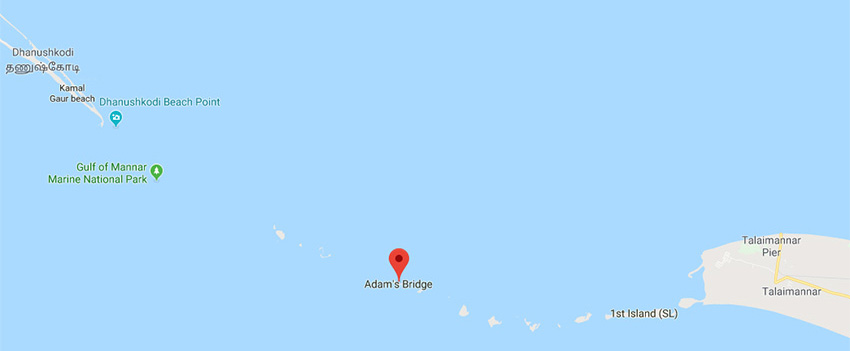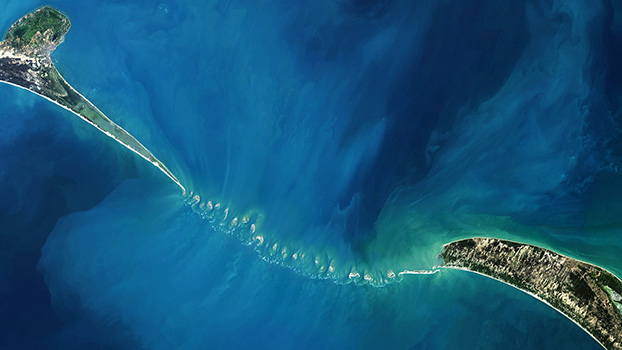Myth and science behind Adams Bridge (Rama Sethu, Rama’s Bridge)
“That beautiful and lovely bridge constructed by Nala across the ocean the abode of alligators, shone brightly like a milky way of stars in the sky”
-Valmiki Ramayana Book VI : Yuddha Kanda : Chapter 22 : verse 72
Adam’s Bridge – Nature Made or Man Made:
The Adam’s bridge is a bridge like Land formation which connects Srilanka (Ceylone) and India. It spans 18 Miles across the South eastern edge of india in the Palk Strait to the present day Srilanka .
It Still remains as a mystery, whether it is natural land formation or according to Hindu belief, it is made by the Lord Rama on the period of Ramayana which is believed to happened in Treta Yuga (a period of time that began 2,165,000 years ago).

Adams’s Bridge in Ramayana:
The Rama Sethu (A Sanskrit word which means Rama’s Bridge) is believed to be built by the lord Rama with his vanara sena (Army of Ape men) to rescue his wife Sita from the demon king Ravana. In the epic Valmiki Ramayana Book six Yudha Kanda, this bridge is described as sethubanthan.
In Ramayana it is also mentioned about the details of how this Rama sethu had been built. According to the Ramayana the Vanara sena – The Army of Ape Man build a bridge between the Rameshwaram to Sri Lanka, with rocks and boulders.
The Bridge building project is headed by a vanara named Nala (According to legends Nala is a son of Architect of gods Vishwakarma) The Bridge building process have lasted for five days and it mentioned as 100 leagues (100 Yojanas) in length.
After the bridge was built, Rama with his army of Vanara across the ocean to Lanka. Once there, the great war happened between Ravana and Rama, Lord Rama killed the demon king Ravan and rescued his wife Sita, and returned to ayodhya.
Evidences which shows it is Man Made structure:
The research led by the former director of the Geological Survey of India Dr. Badrinarayanan, concluded that the Adams bridge AKA Rama Sethu was man-made.
Dr. Badrinarayanan and his team drilled 10 bore holes along the alignment of Adam’s Bridge. They discovered About 6 meters below the surface he and his team found a consistent layer of calcareous sand stone, corals and boulder like materials.
His team was surprised when they discovered a layer of loose sand, some 4-5 meters further down and then hard rock formations below that.
A team of SCUBA divers went down to physically examine the bridge. According to their observations the boulders that they observed were not composed of a typical marine formation. Dr. Badrinarayanan and his team concluded that materials from either shore were placed upon the sandy bottom of the water to form the causeway.
Satellite view of Rama Sethu bridge:
Satellite view image of Rama Sethu or Adam’s bridge was captured by NASA. NASA Images Discover Ancient Bridge between India and Sri Lanka.

Why Rama Sethu is named as Adam’s Bridge:
Rama Sethu is not only attached with Hindu mythology, it also has it’s mythical roots in Abrahamic religions such as Christianity and Islam. As per the Islamic and christian Legends as mentioned in Bible and Quaran Adam the first man traveled in this Natural bridge to reach the Adam’s peak in Sri lanka.
The Adam’s peak in the Srilanka bears the footprint measuring 5 feet and 7 inches by 2 feet and 6 inches. Muslims and Christians believe that this footprint is that of Prophet Adam. As per Prophet Muhammad’s sayings, Prophet Adam was 60 cubits (90 feet) tall.
Many Muslim scholars believe that the first man Adam along with Eve taken out from the paradise (Heavens) by the god and kept in the Adam’s peak. Because of the momentum of his landing on earth was so strong that it is believed to have cast impression of his footprint on the rocks.
There is a tomb named Habil Quabil Dhargah in Rameswaram which also support this mythology.
As per quaran and bilblical story Habil (Abel) and Qabil (Cain) were sons of Adam and Hawwa (Eve), Qabil kill Habil and burried him in a holy place, The Habel Qabil dhargah in rameswaram is believed to be the tomb of Habil.
Adam’s Bridge, a name believed to have been given to it by an East India Company cartographer, he used the name Adam’s Bridge in his map in 1804, by considering the Abrahamic belief over the bridge.
What Science says about Rama Sethu:
Science believed this structure is natural and not made by human activity. There are certain theories which claims the reason of this bridge like structure.
The Adams Bridge is a large Tombolo (Tombolo is natural bridge like land connection which connects lands across the sea).
One theory mentions that this bridge like structure was formerly the world’s largest tombolo that split into a chain of shoals by a slight rise in mean sea level a few thousand years ago.
Another study attributes the origin of the structure to longshore drifting currents which moved in an anticlockwise direction in the north and clockwise direction in the south of Rameswaram and ThalaiMannar. The sand could have been dumped in a linear pattern along the current shadow zone between Dhanushkodi and Thalaimannar with the later accumulation of corals over these linear sand bodies.
Scientific Studies have variously described the structure as a chain of shoals, coral reefs, a ridge formed in the region owing to thinning of the earth’s crust, a double tombolo, a sand spit, or barrier islands.
KeyWords:
Rama Setu, Rama Sethu, Ramar Paalam, Rama’s Bridge, Adam’s Bridge, Rameswaram Sethu, Sethu Bandhanam, Sethu Bandhan.
